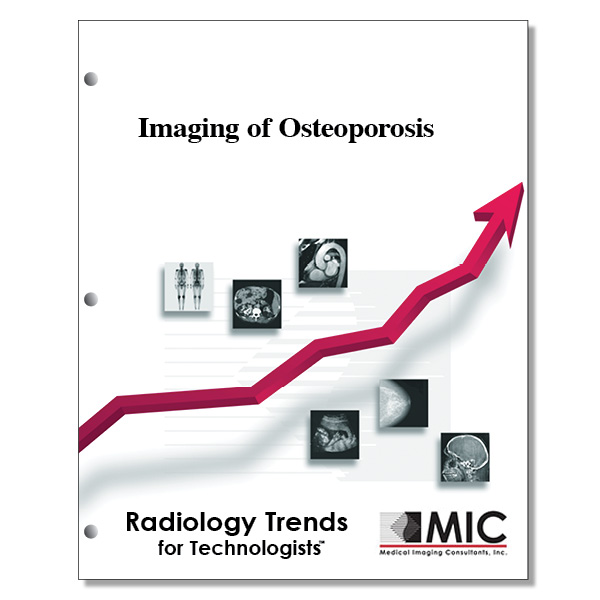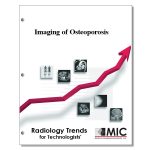

Imaging of Osteoporosis
Improvements in osteoporosis diagnosis are presented leading to better management and treatment.
Course ID: Q00354 Category: Radiology Trends for Technologists Modalities: CT, MRI, Radiography, Sonography4.75 |
Satisfaction Guarantee |
$39.00
- Targeted CE
- Outline
- Objectives
Targeted CE per ARRT’s Discipline, Category, and Subcategory classification:
[Note: Discipline-specific Targeted CE credits may be less than the total Category A credits approved for this course.]
Bone Densitometry: 2.75
Patient Care: 1.00
Patient Bone Health, Care, and Radiation Principles: 1.00
Image Production: 0.75
Equipment Operation and Quality Control: 0.75
Procedures: 1.00
DXA Scanning: 1.00
Computed Tomography: 2.00
Image Production: 0.75
Image Formation: 0.75
Procedures: 1.25
Head, Spine, and Musculoskeletal: 1.25
Magnetic Resonance Imaging: 0.50
Procedures: 0.50
Musculoskeletal: 0.50
Radiography: 2.25
Procedures: 2.25
Head, Spine and Pelvis Procedures: 2.25
Registered Radiologist Assistant: 4.00
Procedures: 4.00
Musculoskeletal and Endocrine Sections: 4.00
Outline
- Introduction
- Definition
- Epidemiology
- Etiopathogenesis and Risk Factors
- Clinical Manifestations
- Role of Diagnostic Imaging
- Conventional Radiography
- Axial Skeleton
- Appendicular Skeleton
- Dual-Energy X-Ray Absorptiometry
- Axial DXA
- Peripheral DXA
- Quantitative CT
- Axial Quantitative CT
- Peripheral Quantitative CT
- Morphometry
- Quantitative US
- Conventional Radiography
- New Advances in the Diagnosis of Osteoporosis
- Differential Diagnosis
- Current Treatment of Osteoporosis
- Conclusions
Objectives
Upon completion of this course, students will:
- know the meaning of osteoporosis and how common it is
- understand which medical imaging modalities are used to diagnose osteoporosis
- understand the role of morphometric measurements in diagnosing osteoporosis
- be familiar with quantitative and semi quantitative techniques for diagnosing osteoporosis
- understand which two anatomical regions are most susceptible to osteoporotic changes
- understand the two classifications of osteoporosis
- compare regional or general osteoporosis to primary or secondary
- understand the disease processes associated with secondary osteoporosis
- be familiar with the EVOS study
- understand quality of life factors for patients with hip fractures
- know the two classifications of bone
- understand the composition of bone
- identify how peak bone mass is obtained
- understand the factors that contribute to bone mass later in life
- be familiar with the risk factors for osteoporosis
- understand bone resorption
- understand bone formation
- compare modifiable and non-modifiable risk factors for osteoporosis
- be familiar with the VERT trial
- be familiar with a “dowagers” hump
- understand which anatomical regions are the most common for vertebral fractures
- identify how conventional radiography is used in the diagnosis of osteoporosis
- understand what anatomical region is represented by Ward’s area
- understand what osteopenia is and how it is diagnosed
- understand the classifications of vertebral spinal fractures
- be familiar with the Genant classification system of vertebral spinal fractures
- be familiar with the uses of radiographic absorptiometry (RA)
- understand the role of DXR in diagnosing osteoporosis
- understand the Jhamaria index
- understand the uses of the T and Z-score from a DXA scan
- understand how the FRAX tool applies to T and Z-scores
- be familiar with the role of QCT in diagnosing osteoporotic disease
- understand dual energy techniques
- describe the roles of pQCT, vQCT, and high resolution CT in diagnosing osteoporotic disease
- know the advantages and disadvantages of each CT technology used for diagnosing osteoporosis
- understand how quantitative vertebral morphometry is used in diagnosing spinal vertebral fractures
- understand the role of QUS in diagnosing osteoporotic disease
- understand the benefits and disadvantages of QUS in the diagnosis of osteoporosis
- explain the role of high resolution CT in the diagnosis of osteoporotic disease
- explain the role of high-resolution MR imaging in the diagnosis of osteoporotic disease
- understand postmenopausal and senile osteoporosis
- know what radiographic signs are associated with vertebral spinal disease
- understand the role of antiresorptive and anabolic pharmacological agents used to treat osteoporosis
- describe the main surgical interventions used to treat vertebral spinal disorders associated with osteoporosis
- describe future techniques which can help diagnose osteoporosis while a patient has their mammogram
